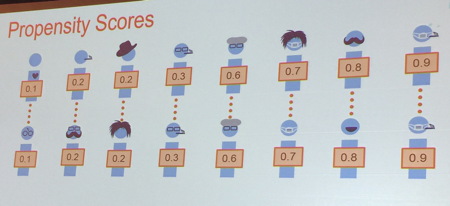SAS Global Forum Random Post 1: Statistics
If you did not go to SAS Global Forum this week, here are some things you missed:
Me, rambling on about the 13 techniques all biostatisticians should know, including the answer to:
If McNemar and Kappa are both statistics for handling correlated, categorical data, how can they give you completely different results?
The answer is that the two test different hypotheses, apply different formula and are coded differently.
McNemar tests whether the marginal probabilities are the same. For example, when you switched your patients from drug one to drug two, was there a decrease in the number who experienced side effects? These are correlated data because they are the same people. Can’t get much more correlated than that.
Kappa tests whether the level of agreement of two raters is greater than would be expected by chance. I’ve rambled on it here before, using it to test the level of agreement that our 7 Generation Games raters have when scoring the pretest and post-test we use to assess whether kids are improving as a result of playing our games. Quick answer: Yes.
You also missed Lucy D’Agostino McGowan’s talk on propensity score matching integrating SAS and R.
Random notes from that presentation:
Why would you want to do this? Well, it would be lovely if you could do a randomized control trial and sending your subjects randomly off to treatment or control group.
However, what if your subjects tell you to drop dead they’re not going to be in your stupid treatment group?
In my experience, propensity scores have been commonly used when evaluating special programs that do not randomly receive patients. For example, patients sent to an Intensive Care Unit tend to be sicker than non-ICU patients. How then, do you decide if an ICU has any benefit when people in it are more likely to die?
Observational studies can use propensity scores to get a more unbiased estimate of treatment effects.
Propensity score matching assumes
- That there are no unmeasured confounders
- Every subject has a non-zero probability of receiving treatment.
Propensity scores are simply predicted values from a logistic regression predicting treatment
Useful rule of thumb:
Use caliper of .2 * pooled standard deviation
Only match people from treatment group to control group if their distance is within the caliper.
Also, I have slide envy because she thought to use mustaches and fedoras in illustrating propensity scores.
Also with really cool slides I was not quick enough to take a picture before he moved on …
Using Custom Tasks with In-memory statistics and SAS Studio by Steve Ludlow
I was able to find the slides from a related presentation he give in the UK last year. I linked to that one because it gave a little more detail on what SAS in-memory statistics is, how to use it and examples. If you had gone to his presentation, you probably would have wanted to learn more about this proc imstat and custom tasks of which he speaks.
Three points you might have come away with:
- Creating custom tasks is really easy
- Custom tasks could be really useful for teams sharing a large data base. Say, for example, you are on a longitudinal project study development of at-risk youth from age 12-25. You might have all kinds of people doing similar analyses, maybe looking at predictors of high school dropout, say. You could save your task and re-run it with next year’s data, only for females or in a hundred other ways.
- Custom tasks could be super-useful for teaching. Have the students run and inspect tasks you create and then modify these for their own analyses.
Okay, off to more sessions. Just a reminder, if you are here and feeling guilt that you left your children/ grandchildren at home, you can buy Fish Lake or Spirit Lake for them to play while you are gone. They’ll get smarter and you will get brownie points from their mom / dad / teacher .

